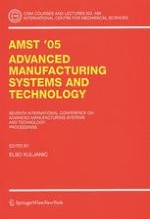2005 | OriginalPaper | Chapter
An Intelligent System for Automatic Extraction of Manufacturing Features from CAD Solid Models Using a Simple and Logical Approach
Author : A. S. Deshpande
Published in: AMST’05 Advanced Manufacturing Systems and Technology
Publisher: Springer Vienna
Activate our intelligent search to find suitable subject content or patents.
Select sections of text to find matching patents with Artificial Intelligence. powered by
Select sections of text to find additional relevant content using AI-assisted search. powered by
Features often form the basis of knowledge about various design and manufacturing tasks like process planning, fixture design, inspection, assembly planning etc. Automatic Feature-s recognition is likely to be an essential requirement for future integrated design and manufacturing systems and in the development of fully automated process planning systems. Majority of the current design and manufacturing data used on shop floors is associated with CAD models. Planning for Product development starts with a 3 D Solid CAD model where as manufacturing drawings are represented in 2 D. Any basic manufacturing process expects the representation of the finished product in terms of an Engineering model. Solid models have replaced the 2D models owing to the trend of the industry towards automation. Any CAD model, when associated with the manufacturing attributes, can be termed as a product model in a general sense. An overview of research on extraction of feature-s from Solid models indicates that, researchers are not comfortable with the drawing interfaces such as IGES, SAT etc. due to dynamic and complex nature of coding. Also, most of the work in this category is based on complicated algorithms. In the perspective of these facts, the present work makes use of the simple and logical approach with DXF interface, which has been so far attempted, only for 2 D CAD Models. DXF has been a widely used interface for wire frame entities, due to clarity and well defined structure. An innovative theory viz.3 Segment theory has been used in for interpreting the features. Further the machining attributes such as surface finish, tolerance associated with the extracted features is used for selecting and sequencing the processes. The decisions are supported by an knowledge based expert system based on a database. The software has been developed in C and an interactive front end has been developed using Visual Basic V6. The concept and the logic used in the system is very much convincing. This would be probably one of the earliest workhaving used DXF interface for extracting the features from Solid Models successfully.
